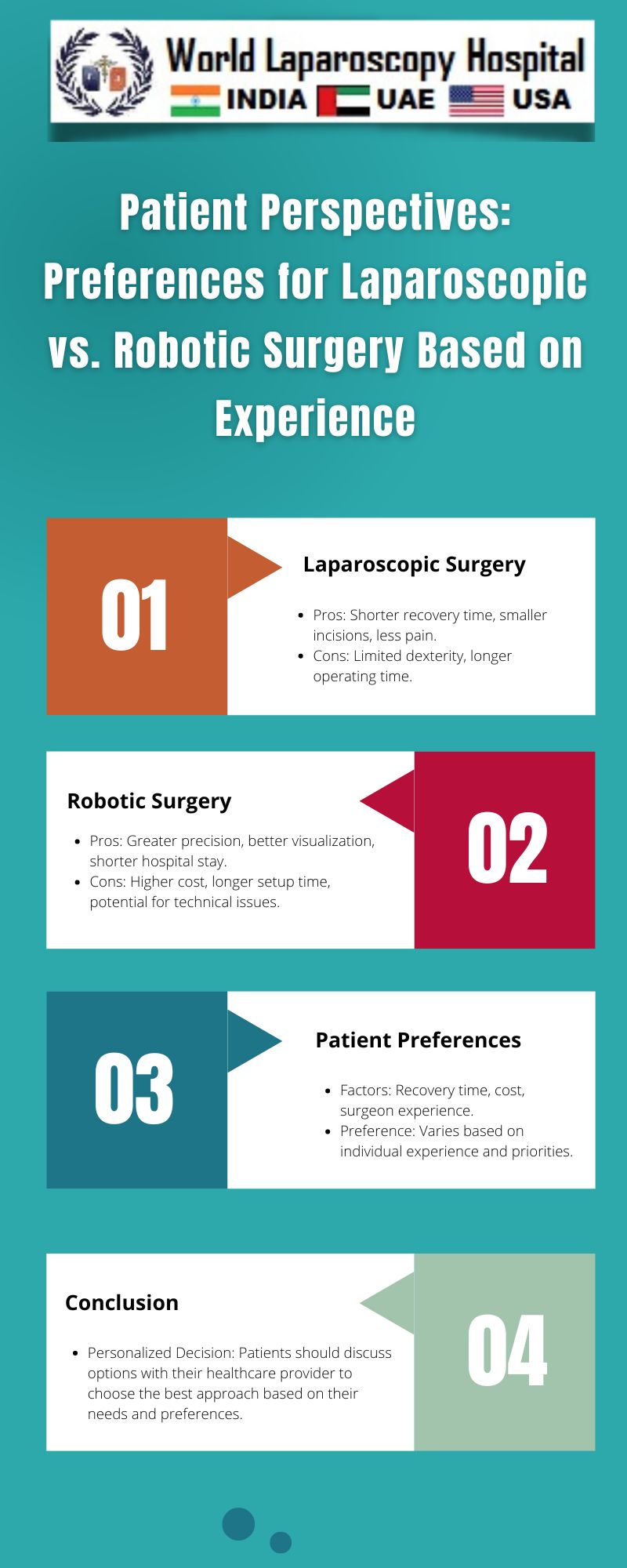Patient Perspectives: Preferences for Laparoscopic vs. Robotic Surgery Based on Experience
Introduction
In recent years, advancements in surgical technology have led to the widespread adoption of minimally invasive techniques such as laparoscopic and robotic surgery. These approaches offer several benefits over traditional open surgery, including shorter recovery times, reduced pain and scarring, and lower risk of complications. However, there is ongoing debate among patients and healthcare providers regarding the relative merits of laparoscopic vs. robotic surgery. This article explores patient perspectives on these two surgical approaches based on their experiences.

Laparoscopic Surgery:
A Tried and True Method Laparoscopic surgery, also known as minimally invasive surgery, involves making small incisions in the abdomen through which a laparoscope and surgical instruments are inserted. The laparoscope provides a magnified view of the internal organs, allowing the surgeon to perform the procedure with precision. Laparoscopic surgery has been used for several decades and is well-established as a safe and effective technique for a wide range of procedures, including cholecystectomy, appendectomy, and hernia repair.
Patients who have undergone laparoscopic surgery often report high levels of satisfaction with the procedure. Many appreciate the smaller incisions, which result in less pain and scarring compared to open surgery. Additionally, the shorter recovery times associated with laparoscopic surgery are a significant advantage for patients, allowing them to return to their normal activities sooner.
Robotic Surgery:
The Future of Minimally Invasive Surgery? Robotic surgery represents the next evolution of minimally invasive surgery, offering several advantages over traditional laparoscopic techniques. In robotic surgery, the surgeon controls robotic arms equipped with surgical instruments from a console, which provides a 3D view of the surgical site. This enhanced dexterity and precision can be particularly beneficial for complex procedures, such as prostatectomy and hysterectomy.
Patients who have undergone robotic surgery often cite the technology's precision and the surgeon's ability to perform complex maneuvers with greater ease as major advantages. The minimally invasive nature of robotic surgery also results in less postoperative pain and a quicker recovery compared to open surgery. Additionally, some patients appreciate the novelty of robotic surgery and feel reassured by the idea of being operated on by a machine.
Patient Perspectives on Laparoscopic vs. Robotic Surgery
The choice between laparoscopic and robotic surgery is often influenced by a variety of factors, including the nature of the procedure, the surgeon's expertise, and the patient's preferences. Some patients may prefer laparoscopic surgery due to its long track record of safety and efficacy, as well as the familiarity of the technique to surgeons. Others may be drawn to robotic surgery for its cutting-edge technology and the potential for improved outcomes.
Patient experiences with laparoscopic and robotic surgery can vary widely. While some patients report excellent outcomes and high levels of satisfaction with both techniques, others may experience complications or dissatisfaction. Factors such as the surgeon's skill, the complexity of the procedure, and the patient's underlying health can all influence the outcome of the surgery.
Conclusion
In conclusion, patient perspectives on laparoscopic vs. robotic surgery are shaped by a variety of factors, including the nature of the procedure, the surgeon's expertise, and the patient's preferences. Both laparoscopic and robotic surgery offer significant advantages over traditional open surgery, including shorter recovery times, reduced pain and scarring, and lower risk of complications. However, the choice between these two techniques ultimately depends on the individual patient and their unique circumstances.
Laparoscopic surgery emerges as a stalwart in the surgical landscape, revered for its time-tested efficacy and minimal invasiveness. Patients laud its smaller incisions and swifter recovery times, attesting to its established track record of safety and satisfaction.
Conversely, robotic surgery beckons as a beacon of technological prowess, captivating patients with its precision and futuristic allure. Those who have undergone robotic procedures extol its advantages, citing enhanced precision and expedited recovery as noteworthy benefits.
By juxtaposing these perspectives, the article not only elucidates the divergent viewpoints but also underscores the intricate interplay of factors shaping patient preferences. As patients navigate the realm of minimally invasive surgery, this article serves as an invaluable compass, illuminating the path toward informed decision-making and optimized patient outcomes.
Laparoscopic surgery, a tried and true method with decades of clinical success, has garnered widespread praise from patients for its smaller incisions and swifter recovery times. Many laud the procedure's minimal scarring and reduced postoperative pain, allowing for a speedier return to normal activities.
Conversely, robotic surgery represents the vanguard of minimally invasive techniques, captivating patients with its cutting-edge technology and promise of enhanced precision. Patients who have undergone robotic procedures often marvel at the surgeon's deft maneuvers and appreciate the technology's role in facilitating smoother recoveries.
However, the choice between laparoscopic and robotic surgery is nuanced, influenced by factors ranging from procedural complexity to patient preferences. While both techniques offer remarkable advantages, patient experiences may vary based on individual circumstances and the skill of the surgical team.
| Older Post | Home | Newer Post |


